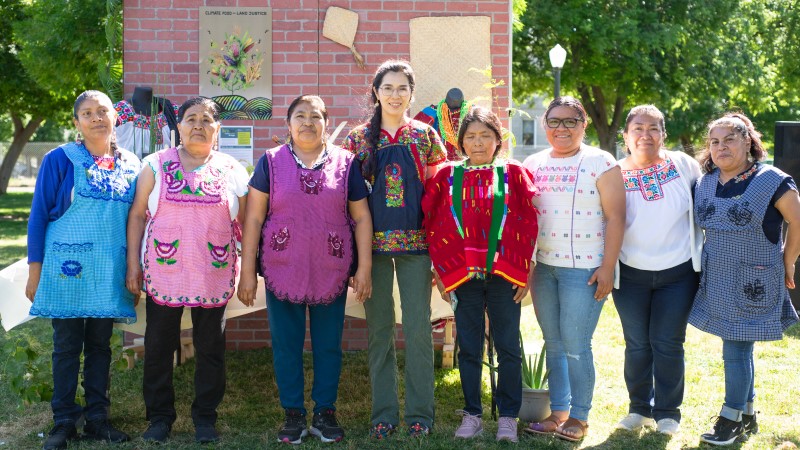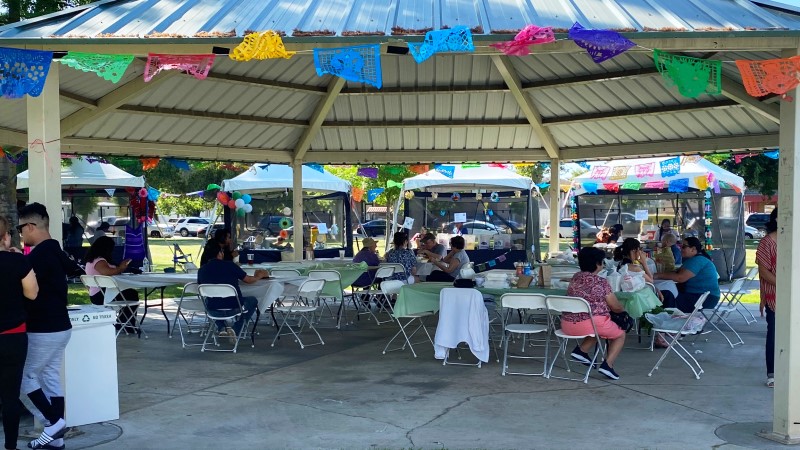
Nu’u Yavi Feature Cooks, from left: Silvia Rojas, Maria Cortez, Ciria Arenas Cruz, Daisy Mejia, Marcelina Bautista López, Kenia Gúzman Paz, Rosa Hernández, Mireya Agustin Lopez Tudor Stanley
During a perfect May afternoon, Madera’s Courthouse Park was transformed into an Oaxacan Nu’u Yavi—a vibrant public space celebrating Mexican indigenous heritage. A recreation of an Oaxacan plaza or market, Nu’u Yavi featured colorful decorations, music, art installations, children playing, unique food, and a community enjoying delicious food while engaging in conversation.
The event was one of many activities that are part of the Pan Valley Institute’s (PVI) economic justice goal. Cultural organizer Rosa Hernandez coordinated this beautiful event.
As the featured cooks—seven indigenous women and their families—prepared for the event, they worried if their unique dishes would be well received. They needn’t have worried, as the homemade Mexican food reminiscent of their homeland was so popular that it sold out before the event’s completion.
Nu’u Yavi’s most significant outcome is the desire it sparked in the participants to continue offering their food, art, and cultural activities in Madera, which will revitalize neglected public spaces like the Madera Courthouse Park.
PVI will continue supporting this collective effort, which will be guided by three objectives:
- Increase and sustain the women’s income generation and economic mobility projects;
- Reclaim, preserve, and innovate cultural, artistic, and Indigenous traditions in food production; and
- Promote the environment and land stewardship.
As part of an economic justice goal, PVI will support this effort for at least one year until the women have the infrastructure to continue it independently.
Meet our Featured Cooks
Mireya Agustín López from Santiago Juxtlahuaca, Oaxaca, is known for her pork pozole, chicken pozole, and chicken tamales in banana leaf. These dishes are among the most traditional in Juxtlahuaca and are never missing on the day of the Nu’u Yavi. They are made from natural corn and yellow chili, which are typical of the coast.
Ciria Arenas Cruz from San Agustín Atenango, Oaxaca, served red mole and yellow chicken mole. Moles are typical of the Mixteca, especially Ciria’s hometown, and combine dried chiles, sesame, garlic, and other ingredients.
Kenia Guzmán Paz from Santiago Juxtlahuaca, Oaxaca specializes in traditional desserts including ticutas, chus, polvorones, and chilacayote empanadas. These desserts are characteristic of Juxtlahuaca. Kenia started making these delicious desserts in Madera in 2016 to offer flavors of Juxtlahuaca to her compatriots living in Madera.
Marcelina Bautista López from San Martín Itunyoso, Oaxaca, specializes in mole tamales with chicken in corn husks, typical of her hometown. The elaboration of tamales and their mole preserve ancestral practices.
Rosa Hernandez from Santiago Juxtlahuaca, Oaxaca, joined us at the event with aguas frescas made from natural ingredients from chilacayote, hibiscus, horchata, watermelon, tamarindo, and lemonade, along with her very own Mole Viko. This mole is made and prepared with the most traditional ingredients of her hometown.
Daisy Mejía says that "cooking ancestral dishes has been a way to connect with my roots and thus preserve my family's traditions. Oaxacan gastronomy reflects the cultural diversity of our state. In addition, the variety of flavors highlights its unique authenticity and emphasis on organic and healthy food. Huaxmole (or mole de guaje) is a stew with many regional variants, but its typical characteristic is guaje seeds. Its origin comes from the indigenous cultures of the Mixtec and Zapotec regions. The mole base is prepared with coastal and/or guajillo chili, garlic, onion, and avocado leaf, accompanied by the protein of your choice. Typically in the Mixteca, huaxmole is prepared with pork or beef."
María Cortez. Originally from Santa María Tindu. Maria's culinary specialty is pel Yiqui, one of the ancestral dishes of the Mixtec region of Oaxaca. This dish's main ingredient is roasted ground corn with chili and avocado leaves. It is cooked in the oven underground. A barbecue of rez, goat, or lamb accompanies it.

A recreation of an Oaxacan plaza or market Eduardo Stanley
